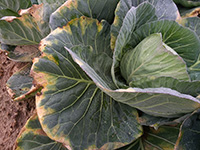As temperatures increase this spring, Georgia cabbage farmers should scout their crops regularly to ensure that disease pressure is not too high, says University of Georgia Cooperative Extension vegetable specialist Andre da Silva.
If farmers are proactive and maintain proper pest management programs during the growing season, diseases like black rot and Alternaria leaf blight can be controlled, da Silva added.
Symptoms of these disease are easy to identify in the field, but once identified, yield may have already been compromised. The increase in temperatures and rainfall can create perfect conditions for disease, and da Silva and Bhabesh Dutta, UGA Extension vegetable disease specialist, are currently tracking the emergence of the two diseases throughout south Georgia.
“As we get to the summer — or later in the spring — the warmer temperatures increase the chance of these diseases,” he said. “If growers don’t pay attention and keep a proper pest management program, we might suffer a high loss.”
According to the UGA Center for Agribusiness and Economic Development, the farm gate value for cabbage in Georgia in 2017 was $53.6 million.
Alternaria leaf blight can cause spots on some brassica crops and render them unmarketable. Symptoms first appear on older leaves as small, dark spots that gradually enlarge with concentric rings. As the disease gets worse, younger leaves become infected. Infection becomes more problematic in humid and wet conditions.
Black rot causes v-shaped lesions on leaf edges which can lead to the plant’s death.
Lack of proper irrigation scheduling could also lead to the appearance of these diseases, particularly due to the application of high volumes of water.
“Since we’re starting to have warmer conditions with frequent rain showers, soil might have plenty of moisture to supply crop demand,” da Silva said. “There is no need to overirrigate, and if growers are irrigating their cabbage in those conditions, it’d create the perfect conditions for disease. That’s what we don’t want.”
As part of his research on the UGA Tifton campus, da Silva is looking for cabbage varieties that are more disease tolerant or disease resistant.
Until disease-resistant varieties are discovered, growers should keep these tips in mind when managing diseases in cabbage:
- Maintain a proper pest management program.
- Rotate chemical products to avoid disease resistance to a particular product.
- Change up irrigation schedules to apply water only when necessary.
- Frequently survey crops for symptoms.
To learn how to identify rot, contact da Silva at 229386-3806 or adasilva@uga.edu. For more information on the Department of Horticulture at UGA-Tifton, visit http://tifton.caes.uga.edu/departments/horticulture.html.







